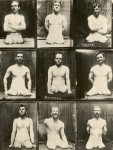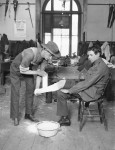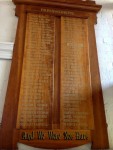MACARTNEY, Dora Lynette
Dora Lynette Macartney
Dora Lynette Macartney (c1881–1934) is one of twenty five nurses commemorated on honour boards at St Peter’s Church Eastern Hill, East Melbourne, for their service in the Great War of 1914. Her family had a long connection with the parish.
Her overseas service was relatively short, less than a year. She served briefly in England, and did transport duty on a ship returning to Australia with invalided soldiers. Her appointment in the Australian Army Nursing Service was terminated after her return. She nursed sick and wounded solders at 11 Australian General Hospital at Caulfield, and then joined the Victorian Baby Health Centre movement in which she worked indefatiguably from 1924 almost until her death in 1934.
Before the War
Dora was one of four surviving children (2s, 2d) of Irish-born George Neil Macartney (c1840–1909) and his Melbourne-born wife Georgina (nee Passmore) (1843–93). George Macartney, a clerk, had arrived alone in Victoria in 1865, Georgina’s parents, John Cowell Passmore (c1815–85) and his first wife Martha Mary had reached Port Philip then in the colony of NSW in 1840. Passmore’s name cropped regularly in the Melbourne press from the 1840s to the 1870s. He began and ended his working life in Melbourne as a painter and glazier, but in between was a publican, caterer, insolvent and litigant.
George and Georgina were both living in St Kilda when they married at St Peter’s Eastern Hill in 1870, but they moved to the western side of Melbourne, bringing up their children in Ascot Vale. George progressed from clerk in the Railways Department to being a successful commercial traveller and his sons Clive and Temple followed in his footsteps. His wife died in 1893, when Dora was 12.
In the early 1900s Dora and her siblings appeared in Melbourne’s social pages at fetes, dances and entertainments, some for worthy causes but many for sheer enjoyment. Their activities centred around the organisations of their neighbourhood of Ascot Vale/Moonee Ponds and surrounding areas, such the Essendon Matrons’ Ball (Australasian, 1.10.1904, p43) and the Northern Golf Club (Punch, 18.6.1914, p39).
About 1909, around the time of their father’s death, both Doris and her sister Denise began training as nurses at the Children’s Hospital in Carlton. The inheritance from their father would have been of assistance with this decision, as he left them, his two single daughters, his entire estate worth nearly £750 to share and share alike (PROV, Wills and Probate).
Doris completed the certificate and the Victorian Trained Nurses Association requirements in 1912. Presumably she then worked as a nurse in Melbourne’s public or private hospitals or undertook private nursing in patients’ homes. It was around this time (1910–13) that her name appeared among the parishioners of St Peter’s Eastern Hill. Nurses gravitated to St Peter’s because of the number of surrounding hospitals and accommodation, and because St Peter’s encouraged the nurses’ social and devotional lives through its branch of the worldwide Church of England Guild of St Barnabas.
War Service
Of the four Macartneys, two enlisted, Dora and her brother. Who enlisted first is hard to determine: although Temple enlisted in June 1916 and Dora in November 1916, Dora had already spent some time in ‘home service’ (as required from midway through the war), nursing repatriated sick and wounded soldiers in two military hospitals in Melbourne, Nos 5 and 11 Australian General Hospitals (St Kilda Rd and Caulfield respectively) (Temple Moore Macartney, Service Record; Dora Macartney, Service Record [NAA])
Temple, a short man aged 37, married and living in Queenscliff, embarked as a private in the 23rd Battalion in October 1916. He served on the Western Front for just three months, being killed in action at Bullecourt on 5 May 1917. He was buried in the field.
Dora sailed with Australian Army Nursing Service general reinforcements on the Orsova in November 1916. They reached Plymouth on 17 February. Temple had marched out from England to France a fortnight earlier so they did not meet.
Dora Macartney was posted to No 2 Australian Auxiliary Hospital in Southall near London. Apart from a brief stint of duty at St Alban’s Hospital in London, where sick Australian sisters were sent, she spent five months at 2AAH. The hospital specialized in treating patients with single and multiple limb amputations, designing manufacturing and fitting prostheses, and preparing the troops for the return voyage to Australia.
The nurses’ work was confronting, caring for amputees, sometime multiple amputees, but the hospital developed pioneering techniques in fitting prostheses and treating patients with them. Dora’s fellow parishioner from St Peter’s Eastern Hill, Muriel Thompson wrote in early 1918:
In this hospital (Southall), we have all our amputation boys. It is so sad seeing them minus limbs but they keep wonderfully bright and cheerful. They are just splendid when they get their new limbs. They practice until they walk perfectly ...The arm cases are not quite so successful, although the boys who have their arms off below the elbow can do everything for themselves. Our orderlies here are mostly men who have done their bit. A great many have one eye out but they get on splendidly with the work.
(Muriel Thompson, Huon Times, 12 March 1918).
Dora would have learned of her brother’s fate at Bullecourt sometime in May. In July, she left the hospital, having been posted to transport duty on the Euripides which was carrying around 1000 invalided men back to Australia (Macartney, Service Record). Although it was dangerous because of potential submarine attacks, transport duty was one way of providing nurses with some respite or with compassionate leave in Australia. There are no details in Macartney’s service record or the hospital war diary.
The Euripides reached Melbourne in September 1917. Macartney did not return to England, in fact several weeks later, she resigned from the Australian Army Nursing (Macartney, Service Record). Again, her service record is silent.
After the War
It appears Macartney returned to 11 AGH, Caulfield to nurse for a time, although the army records office had lost track of her in 1919.
Macartney then changed from repatriation nursing to the growing baby health movement. It was a path a number of returned AANS took; they included several whom Macartney would have known at St Peter’s Eastern Hill, among them a leader in the movement Annie Purcell.
In 1924, Sister Dora Macartney was appointed to run the new baby health centres in Camperdown and Terang, in western Victoria (Camperdown Chronicle, 14.3.1925, p4). She gave talks on baby care, nutrition, sleeping and any topic that would benefit the health of babies and their mothers. As well as running clinic, she was an indefatiguable home visitor to those who could not reach her, getting around on a bicycle or driven by the centres’ lady volunteers. Macartney was lauded for her commitment – she ‘spared neither time nor talents in her labour of love’ and strove ‘for the health of every individual baby that is brought to the Centre or that she sees at home’ (Camperdown Chronicle, 10.12.1925, p6, 10.7.1926, p4). The results were plain to see: her work result in ‘few cases of the much dreaded summer diarrhoea’ in Terang – a disease that was often fatal (Camperdown Chronicle, 16.12.1926, p6).
Macartney resigned from the Camperdown and Terang centres in 1928 (Camperdown Chronicle, 6.12.1928). The work had taken its toll. Writing from the Army Nurses Club in Melbourne, she sought assistance from the Edith Cavell Trust Fund for sick and needy army nurses (Edith Cavell Trust Fund, M290 [NAA]). A long rest had been advised and she had no repatriation or other pension to draw on. The trustees provided her with £25.
Macartney recovered and in early 1929 she was appointed to start up another baby health centre, this one in Ringwood/Mitcham on the outskirts of Melbourne (Age, 22.1.1929, p6). She remained there for five years, doing the same work as she had done so successfully in Camperdown and Terang.
Illhealth forced Macartney to resign in 1934. The Edith Cavell Trust Fund provided her with funds in April (‘long rest advised’), and while she was in hospital. She was suffering from tuberculosis (Edith Cavell Trust Fund, M290 [NAA]). At the opening of the new baby health centre in Ringwood in November, special tributes were paid to her ‘excellent work’ (Age, 27.11.1934, p9).
By then, Macartney was terminally ill in the Austin Hospital in Heidelberg. She died there on 28 December 1934, aged 53 (Argus, 29,12.1934, p9). She was buried in Fawkner Cemetery, on the side of Melbourne where she grew up.
Janet Scarfe
Adjunct Research Associate, Monash
21 September 2016



